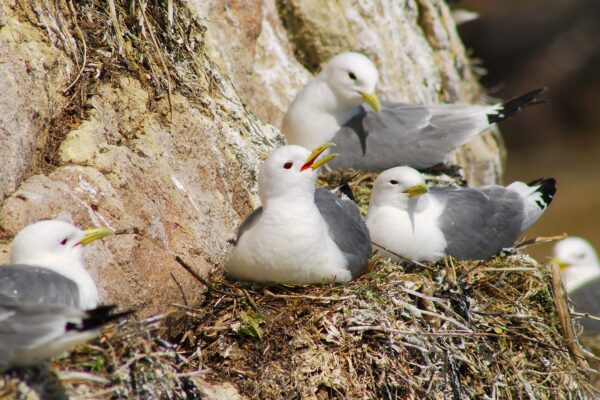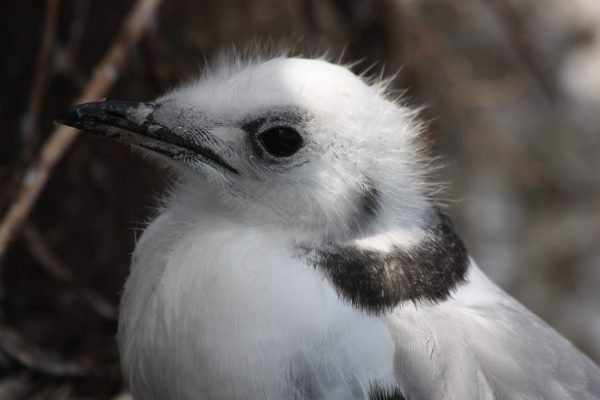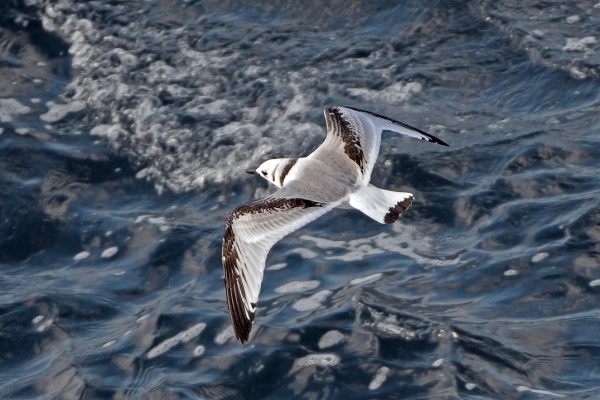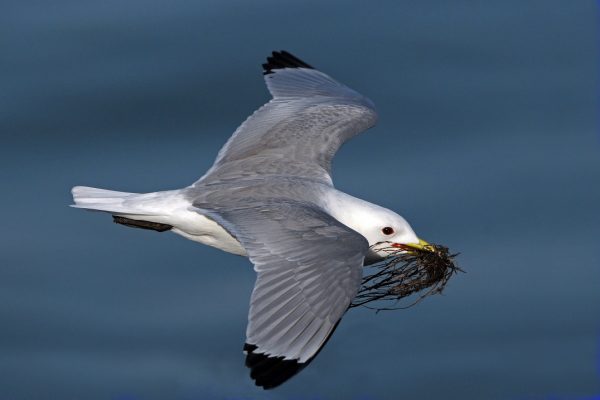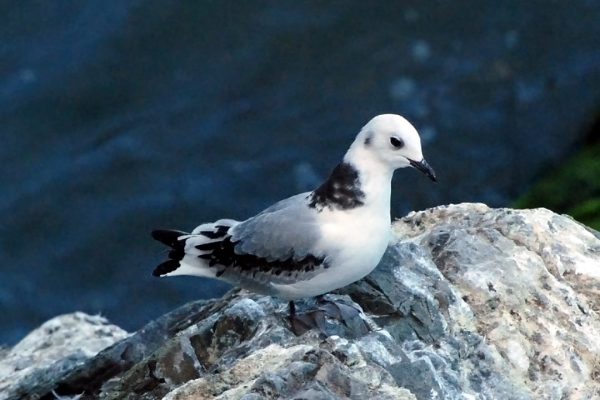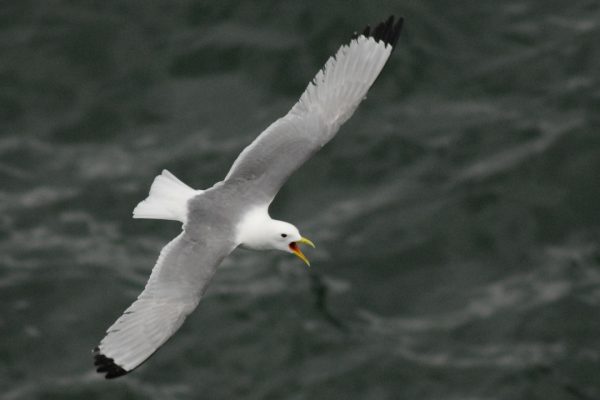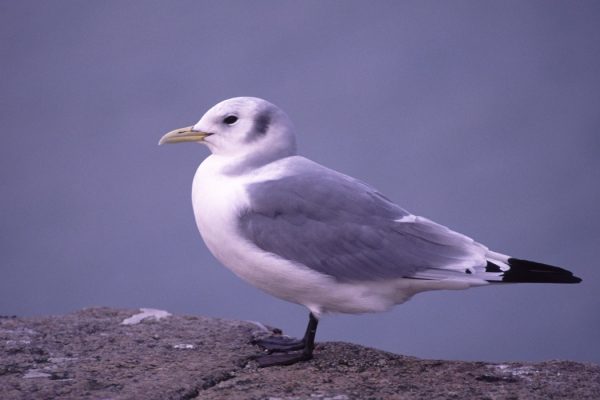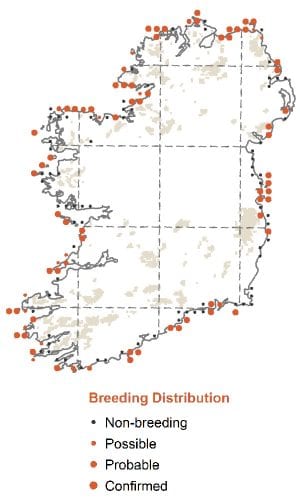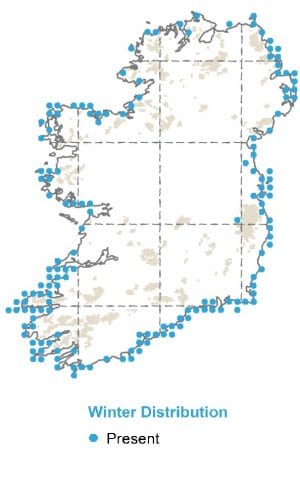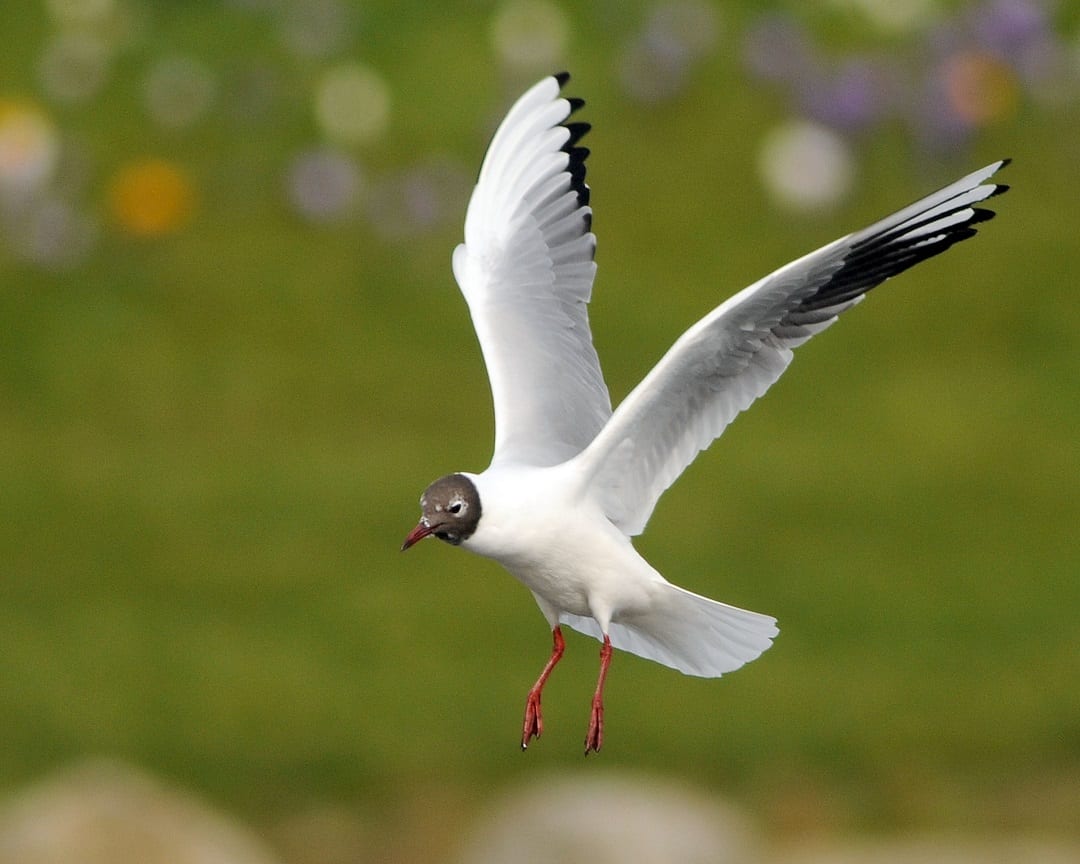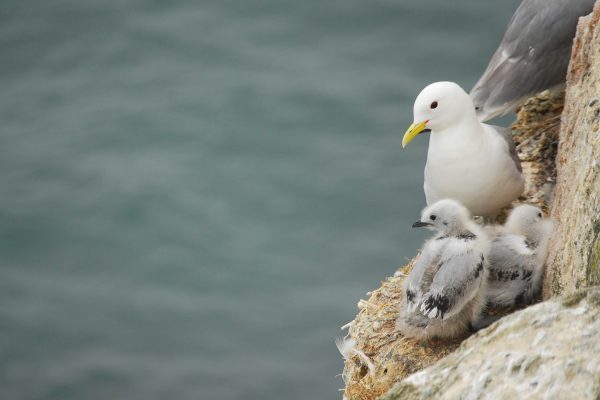
Kittiwake
| Irish Name: | Saidhbhéar |
| Scientific name: | Rissa tridactyla |
| Bird Family: | Gulls |
red
Conservation status
Conservation status
Status
Summer visitor to steep coastal cliffs along all Irish coasts. Disperses to the open ocean in winter and less frequently seen.
Identification
A small gull, slightly larger than Black-headed Gull, which is basically grey above and white below. Adults are easily told apart from other gull species by the solid black wing tips, showing no 'mirrors' (white at the wing tip), and two toned grey upperwing. Adult birds have a yellow bill and dark legs. Adults show white heads in the summer and a dark patch behind the eye in the winter. Juvenile and first year birds have a bold dark 'W-pattern' across the wing and a dark tail band, although these features can be much faded by the first summer/second winter. Second year birds are similar to adult birds but can show black fringes to outer primaries, black on the bill or winter head patterning in the summer months.
Voice
Noisy at colonies, giving a nasal call resembling its name. Can often be heard clearly over the sounds of other birds at seabird colonies.
Diet
Fish, waste from commercial fishing and invertebrates.
Breeding
Forms colonies, sometimes thousands strong, often with other seabirds. Breeds on steep sea cliffs where it builds a nesting platform on the most vertical and sometimes improbably steep areas. Will occasionally use man-made structures such as old buildings, for example in Dunmore East, Co. Waterford.
Wintering
Winters at sea.
Monitored by
Breeding seabirds are monitored through breeding seabird surveys carried out every 15-20 years.
Blog posts about this bird
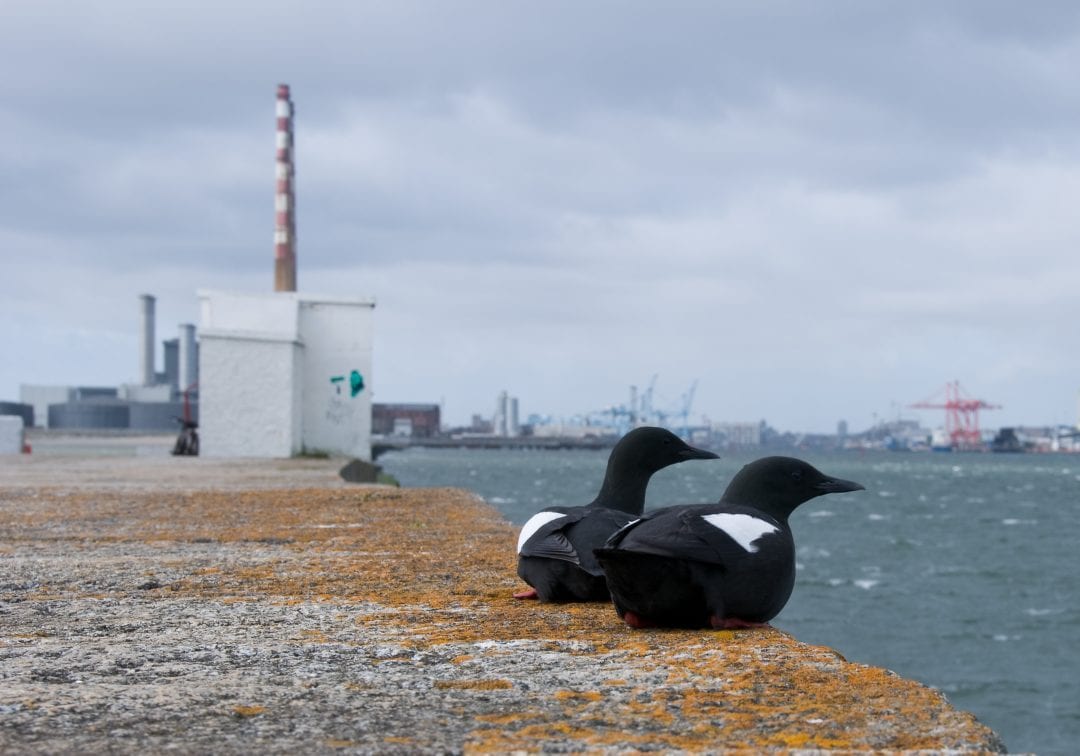
Embracing our maritime heritage this National Heritage Week
National Heritage Week takes place from 17th-25th August 2024. National Heritage Week celebrates Ireland’s cultural, built and natural heritage, uniting communities, cultural institutions, academics and organisations to build awareness about the value of heritage and support its conservation.
By Rosalind Skillen
Over the years, National Heritage Week has grown to become an island-wide event celebrating all aspects of our built, natural and cultural heritage.
It may be surprising to learn that policy related to the marine environment and foreshore section sits in the Department of Housing, Local Government and Heritage – not the Department of Environment, Climate and Communications, as some may assume. This reflects the fact that, as an island nation, our history and heritage have been shaped by the sea and Irish rivers, lakes, and wetlands.
It is also one of the primary reasons why the nine day-long National Heritage Week now includes a Water Heritage Day, held in partnership with the Local Authority Waters Programme. Water Heritage Day is happening on Sunday 25th August 2024 and the day celebrates water throughout Ireland, its history, heritage and our connections with it. It also gives us the opportunity to reflect on the importance of water to our daily lives and consider what more we can do to conserve this valuable resource.
The theme of this year’s National Heritage Week is “Connections, Routes and Networks”, inviting us to explore the ways we are connected to each other through physical or cultural connections.
When we think about the relationship between these three strands – heritage, the sea, and connection – there are several dimensions to this relationship. The sea connects us to the natural world. It also connects people, places, cultures and economies. It is a site of trade and transportation, an issue of mutual benefit and cooperation, and a home for many diverse ecosystems that are bound together in a complex web of ecological interdependence.
Take the Atlantic Ocean off the west coast of Ireland. To take the 2024 theme of “Connections, Routes and Networks”, the waters in the Atlantic transported millions of Irish emigrants to the New World in one of the most tragic periods of Ireland’s history. Where sea meets shore, the Atlantic is renowned for its stunning and rugged coastline, its deep maritime heritage, strong history of fishing, and its variable and windy weather. This is one of the most important coastlines for seabirds, with Galway Bay and surrounding islands hosting some of the largest aggregations of Kittiwake, an internationally important breeding population of Guillemot, as well as important colonies for Puffin, Razorbill and Fulmar. Further north in Mayo, the coastline contains breeding sites for Terns, Auks and Fulmar.
Covering 1/5 of the Earth’s surface, the Atlantic is not only part of Irish heritage but is also a connector. The Atlantic not only connects two continents and serves as a network for global trade, but it also is a route used by seabirds from the UK, Ireland and the US. Seabirds from all 3 nations use the Atlantic as a migration route for breeding and feeding, and there is data showing that US and Irish birds use one of our most important MPAs (NACES) nestled in the heart of the North Atlantic Ocean. In 2021, OSPAR designated NACES as an MPA following research led by BirdLife International, which used tracking data from 21 species of seabirds across 56 colonies. This tracking data revealed that 5 million birds, including Puffins that breed on Skellig Michael, use the NACES MPA every year, making the site a seabird hotspot. A “connector” in the truest sense, the site is one of the most significant congregations of migratory seabirds in the Atlantic.
Conclusion
As the summer draws to a close, with many looking forward to a new routine or the return of school, National Heritage Week offers an opportunity to look back and to appreciate our coasts, seaports and vast maritime area.
Crucially, protecting the marine environment will be vital to preserving our rich Irish heritage for future generations. At the time of writing, we are still waiting for the publication of national Marine Protected Area (MPA) Bill, a vital piece of legislation that would see 30% of Ireland’s water designated as MPAs by 2030, including 10% strictly protected. The MPA Bill was promised in the Programme for Government (2020), and multiple Government announcements and speeches thereafter. We need robust marine protection and effective management of Irish waters to protect the rich maritime heritage that we enjoy across Ireland, and to preserve it for more generations to come.
Find out more about Fair Seas campaign to protect 30% Irish seas by 2030:
FairSeas | Building a Movement of Ocean Stewardship
Find out more about events taking place during National Heritage Week:
Home | National Heritage Week 17th – 25th August 2024
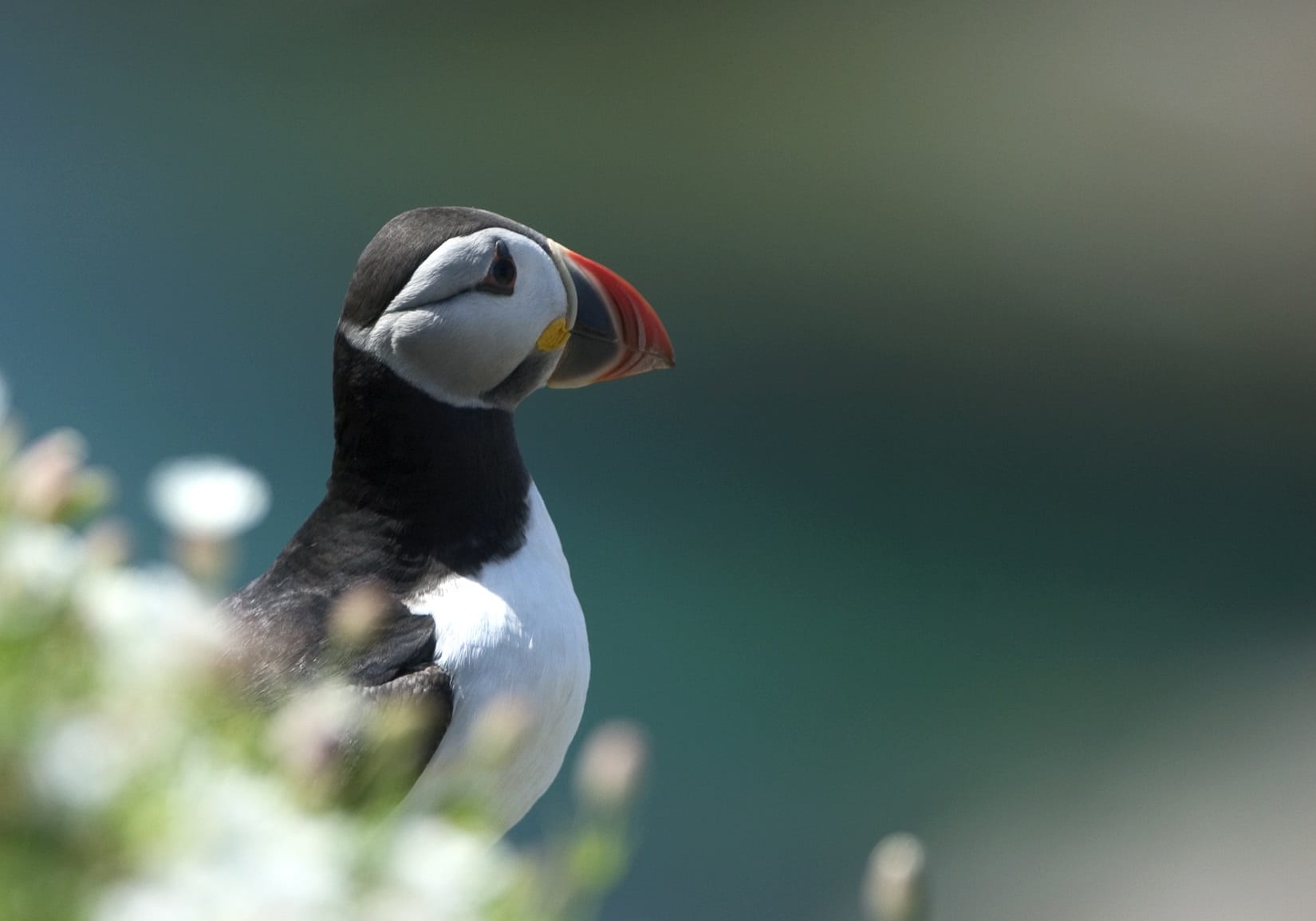
How you can take meaningful action this World Ocean Day
Saturday, June 8th marks World Ocean Day.
As an island nation, we have a strong physical and cultural connection to the sea. Indeed, the Fair Seas Ocean Literary Survey revealed that 99% of people feel marine protection is important to them, with 60% experiencing awe or wonder when they think about the marine environment. While this survey was the first of its kind in Ireland, the maritime traditions, art and literature of our ancestors would indicate that they felt much the same about our oceans.
However, today’s widespread interest and awe in the marine environment has an undercurrent of concern. We know from research that our marine environment and the life that depends on it is in trouble owing to pressures including climate change, pollution and overfishing. Oceana’s 2022 ‘On the Brink’ report highlighted the detrimental effect that overfishing has had on fish stocks in the Northeast Atlantic. Species like anchovy, eel, herring, horse mackerel, Norway lobster, sardine, and whiting, among others, have one or more stocks that are known or considered to be depleted. The most extreme case is that of cod, with nine depleted stocks – the highest number across the whole region.
For seabirds, healthy oceans provide a consistent food supply. When oceans are degraded and fish stocks depleted, it can have detrimental effects on seabird populations, adding to the many other pressures that these species are already facing. Of the 24 breeding seabirds in Ireland, 23 are Red- or Amber-listed Birds of Conservation Concern. Kittiwake, Puffin and Razorbill have joined the Red list having previously been Amber-listed, while the Kittiwake and Puffin are now classed as globally vulnerable.
We have cause for concern for other species, too. A recent report from Fair Seas and the Irish Whale and Dolphin Group (IWDG) highlighted the lower than expected numbers of Harbour Porpoise found in two Areas of Interest (the Southwest Coast and Loop Head to Kenmare River) surveyed, including in a Special Area of Conservation (SAC) designated for Harbour Porpoise. This decline is consistent with the findings of other recent surveys in three other SACs with this species as a qualifying factor.
However, all is not lost for, where there is curiosity and passion, there is hope. The theme of World Ocean Day in 2024 is "Catalyzing Action for Our Ocean and Climate". There is one fast but meaningful way you can take action to benefit the marine environment this World Ocean Day: Call on your Ministers to publish the MPA Bill.
There are many threats facing our oceans and, at present, government inaction is high on the list.
We know that many of the challenges facing the marine environment could be reduced with proper marine protection. However, it’s been nearly a year since the government promised to publish a Marine Protected Area (MPA) bill and, with just a handful of days left before the Dáil summer recess, this vital legislation still hasn't been introduced.
With less than one year left before the current government ends, the bill must be published urgently and moved effectively through the different stages of the Oireachtas in time if it is to have a chance of being passed at all.
Only One and Fair Seas are encouraging petition signers and Irish citizens to keep up the pressure and send letters to Minister Darragh O’Brien and Minister Malcolm Noonan directly, using our email tool, to urge for the swift publication of the MPA legislation. It only takes two clicks and several seconds to have your say. You can access this tool here: Write to Your Ministers: No Time to Waste to Protect Ireland’s Seas (only.one).

